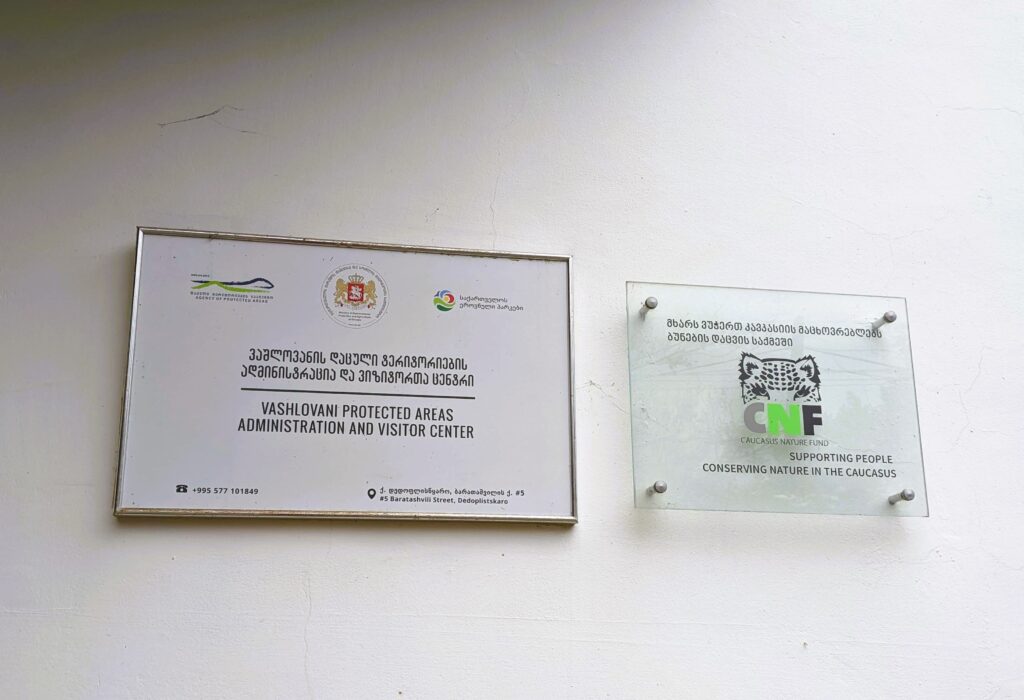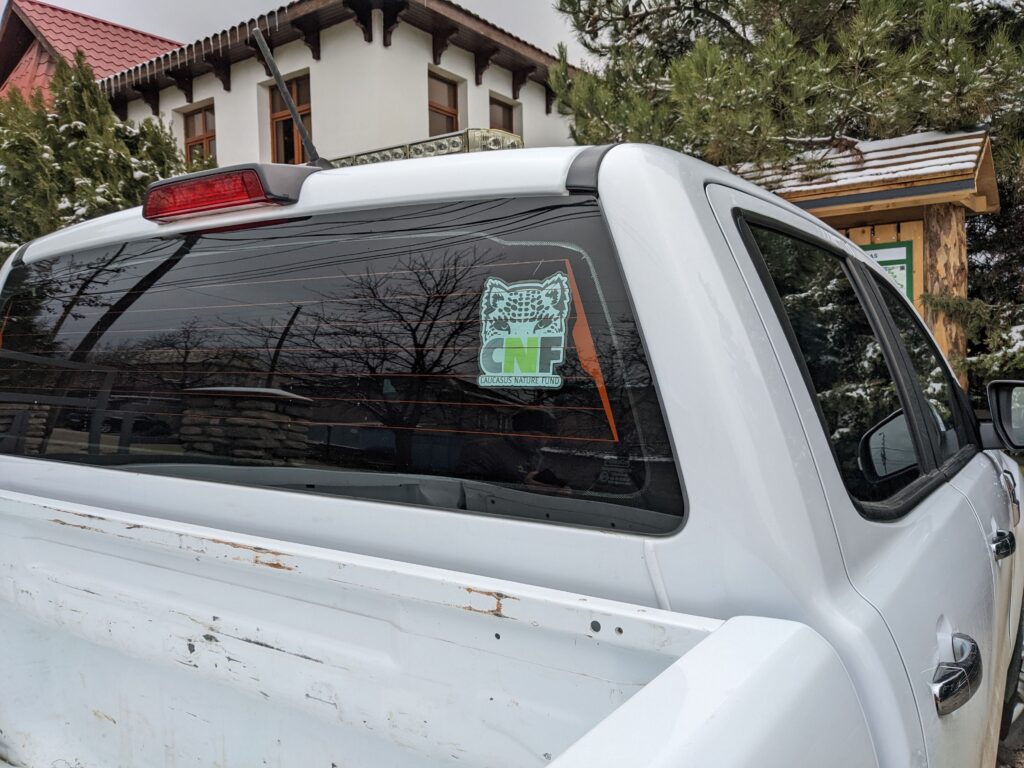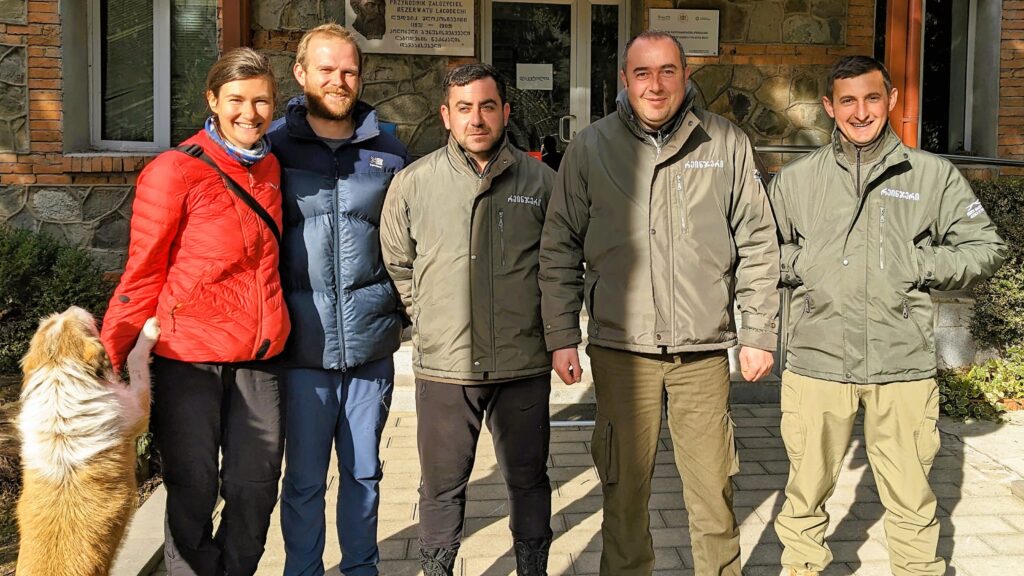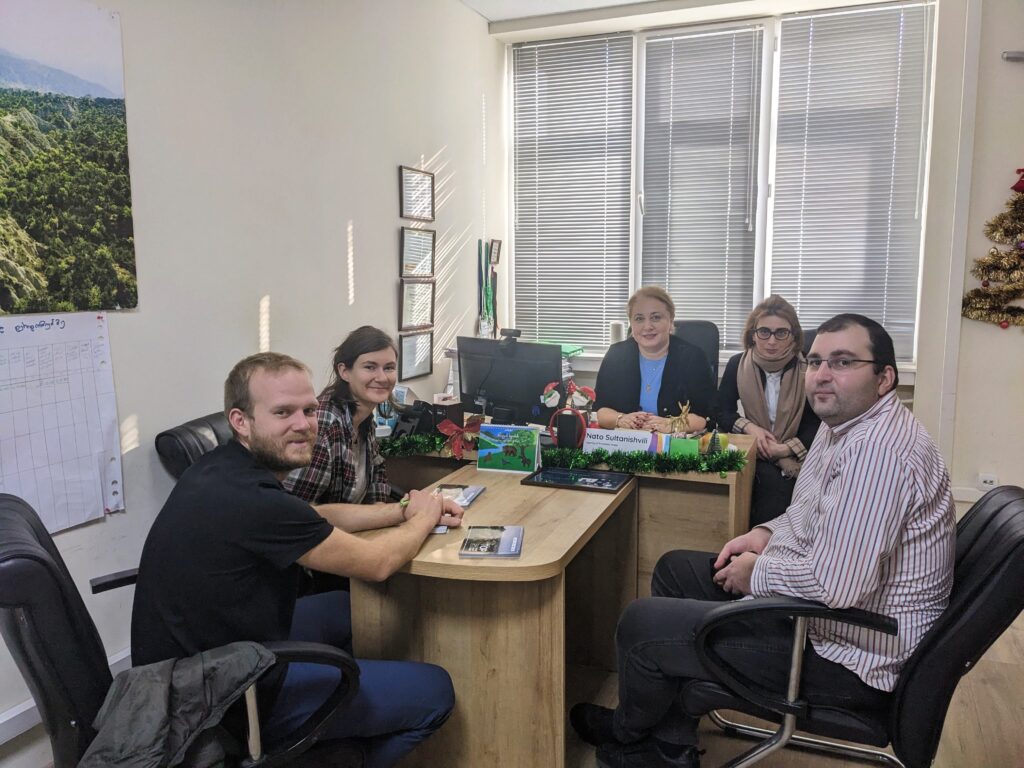The Post-Soviet era was amongst the most turbulent periods in the history of Georgia. A civil war in Tbilisi (1991-1992) and two separatist wars that broke out in the regions of South Ossetia (1991-1992) and Abkhazia (1992 -1993) devastated the country. In five years Georgia’s GDP shrunk by a shocking 78% and its government was unable to provide even basic services to citizens. In this troubled period, the interest and willingness to protect the natural environment of the country – which is undoubtedly one of Georgia’s biggest assets – didn’t come from one day to another. However, today, Georgia has 95 protected areas and counting. 13% of the country is protected, and within the last 30 years, several key instruments have been set up to put Georgia on the right course to safeguard its unique nature.
In our two months in Georgia, we have met many people who work in the field of nature conservation: protected area staff including rangers and visitor centre specialists, environmental NGOs, the government’s Agency of Protected Areas and activists to get an insight into nature conservation in Georgia has developed since the collapse of the Soviet Union and, most importantly, the way forward for the future. In this article, we want to cover three important pillars in Georgian nature conservation which we have not specifically covered so far: funding, the political agenda to enlarge the protected area network, and the work of rangers.
The Caucasus Nature Fund: vital support in funding
Established in 2008, the Caucasus Nature Fund (CNF) is a German-based trust fund. It was founded with the clear vision to provide financial support for nature conservation efforts in Georgia, Armenia and Azerbaijan, the three countries that form the core of the South Caucasus Ecoregion, one of the most biologically rich areas on Earth.
“The idea of creating a trust fund came back in 1995 connected to the first Georgian program by WWF Germany, which was the establishment of Borjomi-Kharagauli National Park, the first national park in independent Georgia. After its successful establishment, it quickly became clear that additional funding is necessary to maintain protected areas in Georgia.” Tea Barbakadze, CNF country director for Georgia explains. “Following that, the first project emergency fund by the newly established Caucasus Nature Fund was deployed to Borjomi Kharagauli after the 2008 war. Soon after, in December 2009, CNF signed a framework agreement with the national governments of Armenia and Georgia about the support of protected area development based on IUCN guidelines.”
From this moment on, the Caucasus Nature Fund became a very important instrument in the nature conservation field of Georgia and Armenia. CNF works closely together with governments, but is not replacing them. “We started with a funding of only €8 million, and now we manage almost €100 million in assets that support an annual program of more than €2 million. We are really proud of this achievement, and we are considered a best practice example as one of the trusts managed by the Nature Trust Alliance.” Tea tells us.
CNF supports specific government activities with additional funding to date for 12 protected area administrations in Georgia, such as Tusheti, Borjomi-Kharagauli, Lagodekhi and Vashlovani protected areas. However, through successful fundraising, CNF has secured its budget and is able to extend its support to further protected areas already this year.
“Our financing comes from varied sources. Over time, our donors were concerned about measuring the impact and requested a more direct involvement, so CNF stepped in to provide a variety of technical expertise and resources that the ministry is lacking. We are the coordinator of multiple projects, but not the implementor. The protected area administrations we support receive vehicles, equipment and salary top-ups, but it is important to mention that costs are split at least 50/50 between us and the state. In this way, we encourage the governments to invest more into protected area development in the coming years. Thankfully, we see that our efforts are successful and the investments and salaries coming from the state are slowly but steadily increasing.” adds Tamar Pataridze, project manager at CNF.
Furthermore, during the Covid-19 pandemic, CNF was crucial to keep the protected areas above water and covered more costs than usual to counter the tight state budget.


The support of the Caucasus Nature Fund is visible in all protected areas we visited in Georgia.
Currently, CNF has three main focal areas in the Caucasus. Firstly, it aims to ensure the financial sustainability of protected areas, investigate financial situations, needs, and income sources. For example, Tamar tells us that CNF is a big supporter of introducing entrance fees to protected areas.
Secondly, CNF funds the establishment of biodiversity baseline data and capacity building of rangers. Its projects fund biodiversity surveys in multiple protected areas, which are conducted with external experts such as NACRES, supported by local rangers.
And the third part of CNF´s aims is awareness raising, mainly among decision-makers. “We see a systemic change. We work together with the Agency of Protected Areas of Georgia and although our work doesn’t come without challenges, we see nature conservation develop in the right direction.” Lika, project manager of CNF explains, and Tea adds “This is my favourite part of our work: to witness how CNF creates change in our own country, on various levels.“



Tea, Tamar and Lika from the Caucasus Nature Fund have observed a systemic change into the right direction within Georgian nature conservation efforts.
The Agency of Protected Areas: strengthening political will
There have been many efforts to protect Georgia’s most valuable habitats as protected areas. Especially after the country’s independence in 1991, Georgia started declaring national parks and others, amounting to 95 protected areas in 2023. These protected areas are all under the management of the Agency of Protected Areas of Georgia (APA), an independent governmental entity.
Another boost has been the identification and partial designation of 49 Emerald sites, the equivalent to NATURA 2000 sites, which is a requirement to seek membership of the European Union. Hence, the Agency for Protected Areas told us that they will meet their goal to put 30% of Georgia’s land under protection until 2030.
“We take the protected area classifications of IUCN and the national protected area law very seriously, and aim to put all Georgian biodiversity hotspots under good protection.” explains Nato Sultanishvili, head of the Planning and Development Division within APA.
Currently, 13% of Georgia is under protection and management of APA. On top come Emerald sites and protected landscape areas that are managed by municipalities in cooperation with the APA. Nato tells us that several new protected areas, such as Guria National Park and Racha National Park are in the process of being approved, and in the coming year they will be officially established. “The state is on our side, and our requests for further protected area designations are successful” Nato emphasises. Furthermore, continual cooperation with international organisations such as CNF, GIZ and the German development bank KfW offers opportunities for APA to further its efforts.
Continuing this course does not only benefit the biodiversity of Georgia, but also the growing tourism sector. Nato shows us the most recent tourism statistics of 2022, which confirm that the most iconic national parks are tourist magnets. “In Tusheti there are now 70 guesthouses, and there used to be only ten families living there.” adds Lado Trapaidze, project manager at APA. According to the 2022 statistics until November, the 2019 pre-covid numbers were already surpassed. What is also great to see is that nature tourism is also popular among locals. In 2022, 52% of tourists were domestic and 48% were foreigners.
According to Nato and Lado, one of the biggest achievement of APA is that in 2021, for the first time in the history of Georgia, 4 protected areas, Kolkheti and Mtirala National Parks, Kobuleti and Kintrishi Protected Areas, were inscribed on UNESCO World Natural Heritage Lists for their unique Colchic Forests and Wetlands. In Nato´s words:
“We work hard to gain international recognition for our unique protected areas, and it is fulfilling to witness that our efforts pay off.”
Rangers: on the frontline of nature protection
Just like their colleagues worldwide, the 450 protected area rangers of Georgia protect the rich and endangered natural heritage of the country, while ensuring the safety of tourists and communities living near protected areas. Their work also involves putting their own lives at risk to combat poaching, illegal logging, forest fires and other types of environmental destruction. Nevertheless, the ranger profession has not been valued properly in Georgia, as in many other countries.
However, the Caucasus Nature Fund aims to change that. As we visited several protected areas, we often heard of CNF, who provides uniforms, vehicles and other types of crucial equipment, such as smartphones and binoculars, to rangers. Moreover, CNF aims to introduce SMART patrolling across Georgian protected areas, which makes the collection and evaluation of data in protected areas much more effective. CNF even organised trainings for protected area administrations, and in Lagodekhi Protected Areas, SMART is already in use.


With the rangers of Vashlovani and Lagodekhi Protected Areas.
Every kind of biodiversity monitoring work that CNF contracts to experts such as NACRES must involve rangers as well. In this way, they can learn about the latest techniques in species monitoring and data collection. Other capacities are built by CNF through e-learning lessons and physical trainings aimed at rangers, such as on first-aid and fighting wildfires.
Rangers deserve much more recognition for defending Georgia´s nature, and people as well as the government have to value this work accordingly. The most important way to do this is to increase their currently very low salaries and other types of financial coverage to at least the level of police officers, and this is what CNF is lobbying for. Tamar explains that introducing a reasonable incentive system for outstanding work is the vision of CNF, and the fund is willing to cover part of these costs if the government delivers its part. This would also motivate the younger generation to consider doing this important job to preserve their country’s rich natural heritage.
Along this line, CNF also introduced the Annual Ranger Awards, the most fascinating idea to us. Launched recently, CNF, in cooperation with the APA, created awards in four categories: anti-poaching, community efforts, combating illegal logging and conservation. Each award is named after a ranger who had an outstanding contribution in that field, such as the Merab Arevadze award named after a ranger killed by poachers in Borjomi-Kharagauli National Park in 2012, or the Vano Kupradze award following the death of a ranger fighting a wildfire.
Overall, we were very impressed by the dedication of all those professionals who work to improve nature conservation in Georgia. During our time here, we encountered a huge natural diversity, a lot of passion and dedication by the people who aim to protect it, and most promisingly, many concrete efforts that pave a good way forward.


A big thank you to the Caucasus Nature Fund and the Agency of Protected Areas for sharing their experiences with us!

